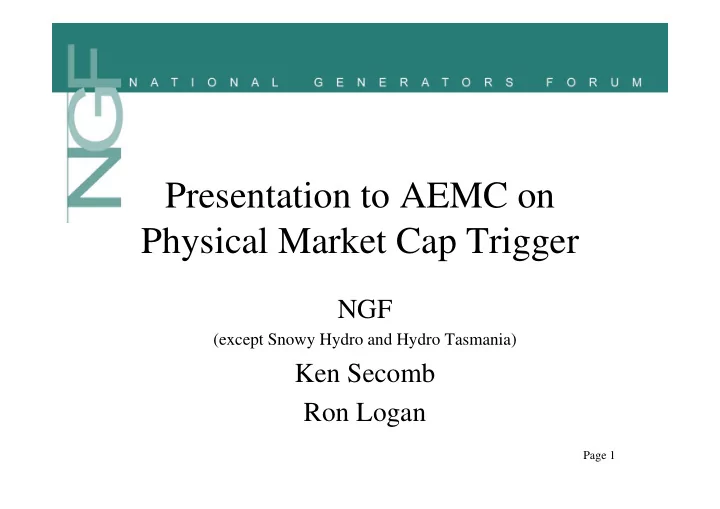

Presentation to AEMC on Physical Market Cap Trigger NGF (except Snowy Hydro and Hydro Tasmania) Ken Secomb Ron Logan Page 1
Market Price Limit • The Market Price Limit is subject to tension between competing objectives – • It should be high enough to allow the price signals necessary to maintaining supply reliability, but • A high limit results in high risks to participants, adding to participant costs, and hence ultimately to consumer costs • The Reliability Panel is faced with this tension Page 2
Temporary lower price caps • The current market design already recognises the value of a lower price cap when the reliability issue is not at stake – • A lower price cap (the APC) is applied when the cumulative reliability signal during a high price event reaches a defined trigger value • This NGF proposal applies the same lower price cap, in this case under conditions when high prices are likely to occur, but would not contribute to investment for future reliability Page 3
NECA consideration • NECA considered that some market risks should be mitigated and focussed on two risk mitigation measures – • Measures based on defined Force Majeure events (but they found it difficult to define these comprehensively), OR • Measures based on the market price outcome (which became the Cumulative Price Threshold/ Administered Price Cap provision, now in the Rules) Page 4
This proposal • The NGF proposes that the “OR” should be “AND”, • I.E. retain the existing mechanism, and supplement it with an event-based trigger • The definition of events is much less critical if it is not the only risk-mitigation process; CPT/APC remains as a “backstop” Page 5
Are all high price events beneficial from a reliability perspective? • NO; a prudent investor will not rely on the repetition of rare and unpredictable events to justify investment, • Hence the normal need to have a high Market Price Limit, to support reliability, has little relevance to pricing during rare and extreme market events Page 6
How do we define these extreme events? • Contingency events that may affect the market are already clearly defined in the NEM Rules as either – – Credible contingency events, which NEMMCO must take precautions against, or – Non-credible contingency events against which NEMMCO has no obligation (or right) to take precautions Page 7
The NGF contention • If a contingency event is so unlikely that NEMMCO is not required to take precautions against it, then • Market participants are unlikely to treat any high prices resulting from that contingency event as a meaningful investment signal Page 8
Reliability considerations • The Reliability Standard defines the process for calculation of unserved energy (USE) • Unserved energy resulting from a non-credible contingency event is excluded in USE calculations • This distinction in the Reliability Standard between credible and non-credible contingency events, in the measurement of reliability, further supports the NGF contention Page 9
Secondary conditions • Non-credible contingency events may affect remote or unstressed parts of the network, • These will have little or no effect on the market, • Price capping would be inappropriate if the event has had no material effect on market dispatch, • Materiality tests are included in the proposal, and are used as a secondary filter to confine price capping to appropriate events Page 10
Characteristics of trigger events • The trigger events that the proposal is designed to manage are rare and unpredictable, for example the disruption of 16 January 2007, • But, there are some broad characteristics that may be foreseen - Page 11
Trigger Event Characteristics (1) • A significant network disruption event is likely to isolate some generators from the market, • This is a lost opportunity for revenue, • If an affected generator is hedged, then substantial losses may result • While it is possible to imagine mechanisms to re- arrange the incidence of this risk between participants, the aggregate risk would remain and ultimately be a cost to consumers Page 12
Trigger Event Characteristics (2) • Generators not separated from the market may be dispatched to high levels leading to high prices • [but, as discussed above, such high prices are unlikely to have reliability benefits] Page 13
Trigger Event Characteristics (3) • If load is shed in a disruption event, then a retailer may be left over-hedged in relation to their remaining demand, • This leads to a windfall gain related to both the magnitude of the load shedding, and the market price level Page 14
Requirements on NEMMCO • Non-Credible contingency events are clearly defined in Rules • NEMMCO has an existing need to identify contingency events, including non-credible contingency events, for the purposes of maintaining security and dispatching the market • Impact on dispatch will generally be clear, but in any case can be easily calculated Page 15
Summary • The defined trigger events, if not managed efficiently, are likely to lead to unpredictable wealth transfers, • These risks are not associated with reliability benefits, • The cost of these risks will ultimately be funded by consumers, and hence • The Electricity Objective is furthered by mitigating these risks Page 16
Recommend
More recommend